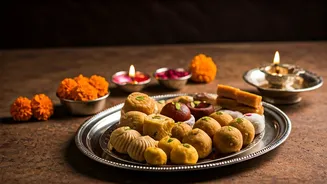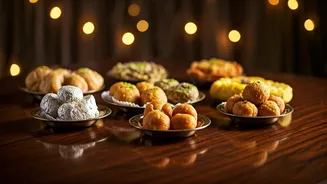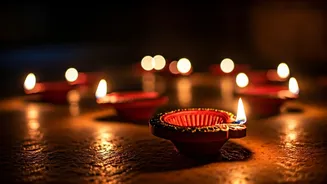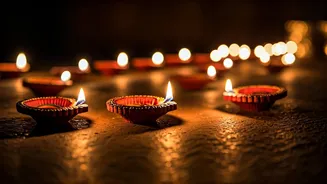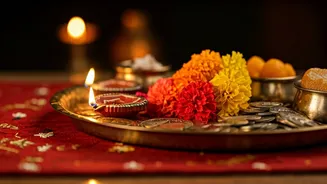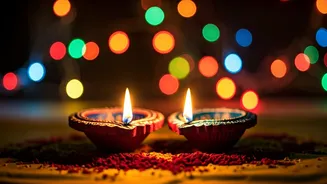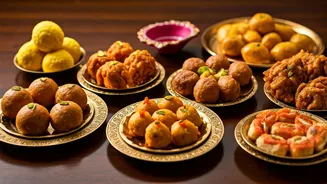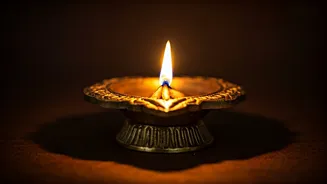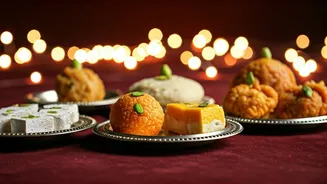Importance of Offerings
The practice of presenting specific foods during Diwali Pooja goes beyond mere culinary choices; it's a symbolic gesture of reverence and a means to invite
blessings. These offerings symbolize different aspects of prosperity, knowledge, and good fortune, welcoming the deities into the home. Each food item is carefully selected and prepared, following established traditions and customs that have been passed down through generations. The offerings are not just consumed; they are first presented to the deities as a token of devotion, which is then shared as prasad (blessed food), fostering a sense of community and spiritual connection among family members and guests. These offerings, along with the rituals, amplify the festive atmosphere and the religious significance of the Diwali celebrations, making them a time of togetherness and spiritual enrichment.
Goddess Lakshmi's Favourites
For Goddess Lakshmi, the deity of wealth and prosperity, various sweets and delicacies are prepared and offered. Ladoo, a round sweet made from gram flour, sugar, and ghee, is a staple, representing abundance and sweetness in life. Kheer, a creamy rice pudding infused with cardamom, nuts, and saffron, symbolizes purity and completeness, inviting positive energy. Halwa, a dessert usually made from semolina or wheat flour, signifies good health and prosperity, and it is considered a must-have in many households during the festive period. Besides these, dry fruits, such as almonds, cashews, and raisins, are offered, representing wealth and the ability to enjoy the good things in life. These items collectively represent the welcoming of Goddess Lakshmi and an invitation for her blessings of prosperity, wealth, and good fortune.
Lord Ganesha's Choices
Lord Ganesha, the remover of obstacles and the god of wisdom, is also offered specific foods during Diwali Pooja to seek his blessings for a successful and trouble-free year. Modak, a sweet dumpling filled with coconut and jaggery, is a particular favourite. It represents wisdom and the potential to overcome hurdles. Motichoor ladoo, another gram flour-based sweet, is offered to represent auspiciousness and sweetness in life's journey. Rice and pulses, cooked together, which is often considered a staple food, signify the basic necessities and stability in life. Various types of fruits, like bananas and mangoes, are also offered, representing the sweetness of life and the ability to enjoy it. These offerings together are seen as an acknowledgment of Lord Ganesha's blessings and an appeal for guidance in all new endeavours, making the offerings a symbol of intellect, luck, and triumph.
Beyond the Offerings
Besides the individual food items offered to the deities, other considerations add depth to Diwali Pooja. The arrangement of the offerings is often done meticulously, with specific placements dictated by tradition. The use of natural materials, like banana leaves, for serving the food enhances the sanctity of the ritual. The preparation itself is an act of devotion, and it is usually done with clean hands and a pure heart. Many families involve all their members in the cooking and decorating to instil a sense of unity and shared responsibility. The rituals and offerings are not just isolated actions, they are integral parts of a larger celebration, accompanied by prayers, hymns, and the lighting of diyas (oil lamps), all of which contribute to the festive and religious spirit of Diwali. The combined elements create a wholesome atmosphere that highlights the holiday's essence.
The Shared Prasad
Once the Pooja is complete, the food items offered to the deities are distributed as prasad. This act of sharing is a cornerstone of the Diwali experience, fostering a sense of community and kinship. The prasad can be anything from sweets and fruits to cooked dishes, all of which are considered to be blessed. It is given to everyone present during the Pooja, regardless of their age or background, symbolizing unity and the shared blessings of the deities. Distributing prasad is not just a gesture of hospitality; it is believed to carry the divine blessings of the deities and bring good fortune to all who consume it. The tradition extends beyond the immediate family, with many people sharing prasad with neighbours, friends, and the less fortunate, thus amplifying the spirit of goodwill and mutual support that defines Diwali.
Modern Diwali and Food
In contemporary celebrations, while the traditional items remain central, there is also a trend toward innovation and adaptation. Many families still follow the traditional guidelines when selecting and preparing Diwali offerings. However, there is growing interest in offering healthy alternatives. The goal is to balance tradition with contemporary tastes. Some families opt for making lighter sweets with less sugar or incorporating fruits and vegetables in creative ways. This blending of the old and the new enables families to uphold their cultural heritage while taking into account their current lifestyles. The inclusion of new items, such as multi-grain ladoos or fruit-based desserts, shows how Diwali has adapted to the changing times, ensuring its continuing relevance and significance in modern India.
Significance of the Pooja
The offerings in Diwali Pooja represent more than just food; they are powerful symbols of values, desires, and reverence. The selection and the presentation of each item represent specific prayers and hopes for the upcoming year. For instance, the sweets symbolize the wish for sweetness in life. The inclusion of dry fruits and nuts represents abundance and well-being. The Pooja itself is a holistic ritual that connects the devotee with the divine, asking for knowledge, prosperity, and the removal of obstacles. The items themselves act as a bridge, conveying the prayers and aspirations of the believers to the deities. Each component, from the meticulously prepared dishes to the chanting of mantras, creates a comprehensive experience that is central to Diwali celebrations.
Regional Variations
Diwali celebrations and the foods offered during the Pooja vary throughout India, highlighting the country's diverse cultural heritage. In some regions, specific sweets or dishes hold greater significance than others. For example, in certain areas, the offering of sweets made from jaggery is considered essential. The selection of fruits may also differ based on regional availability and beliefs. Some cultures also include regional snacks and savouries, enhancing the variety of the offering. These differences show the rich diversity of India and how Diwali is celebrated differently, depending on regional customs and practices. This regional variety enriches the Diwali experience, making it a festival that is inclusive of various traditions and cultural aspects.
Culinary Rituals and Symbolism
Every action associated with Diwali Pooja has symbolic meaning. The use of ghee (clarified butter) in sweets and cooking is believed to purify and represent goodness. Fresh ingredients signify renewal and freshness, welcoming a new beginning. The act of cooking and serving with love and devotion adds to the spiritual impact of the offerings. It transforms a simple meal into an act of worship. The precise arrangements and presentations of the food are also important, often symbolizing the desire to create a balanced and blessed environment. Every aspect of the preparation, from the choice of ingredients to the manner of presentation, is intended to enrich the ritual and emphasize the spiritual significance of the festivities, creating a unique and intimate connection between devotees and the deities.
